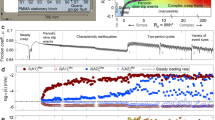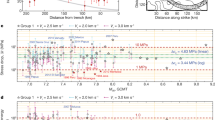Abstract
Temporal changes in seismic velocity during the earthquake cycle have the potential to illuminate physical processes associated with fault weakening and connections between the range of fault slip behaviours including slow earthquakes, tremor and low-frequency earthquakes1. Laboratory and theoretical studies predict changes in seismic velocity before earthquake failure2; however, tectonic faults fail in a spectrum of modes and little is known about precursors for those modes3. Here we show that precursory changes of wave speed occur in laboratory faults for the complete spectrum of failure modes observed for tectonic faults. We systematically altered the stiffness of the loading system to reproduce the transition from slow to fast stick–slip and monitored ultrasonic wave speed during frictional sliding. We find systematic variations of elastic properties during the seismic cycle for both slow and fast earthquakes indicating similar physical mechanisms during rupture nucleation. Our data show that accelerated fault creep causes reduction of seismic velocity and elastic moduli during the preparatory phase preceding failure, which suggests that real-time monitoring of active faults may be a means to detect earthquake precursors.
This is a preview of subscription content, access via your institution
Access options
Subscribe to this journal
Receive 12 print issues and online access
$259.00 per year
only $21.58 per issue
Buy this article
- Purchase on Springer Link
- Instant access to full article PDF
Prices may be subject to local taxes which are calculated during checkout




Similar content being viewed by others
References
Scholz, C. H., Sykes, L. R. & Aggarwal, Y. P. Earthquake prediction: a physical basis. Science 181, 803–810 (1973).
Yoshioka, N. & Iwasa, K. A laboratory experiment to monitor the contact state of a fault by transmission waves. Tectonophysics 413, 221–238 (2006).
Kaproth, B. M. & Marone, C. Slow earthquakes, preseismic velocity changes, and the origin of slow frictional stick-slip. Science 341, 1229–1232 (2013).
Niu, F., Silver, P. G., Daley, T. M., Cheng, X. & Majer, E. L. Preseismic velocity changes observed from active source monitoring at the Parkfield SAFOD drill site. Nature 454, 204–208 (2008).
Chen, J. H., Froment, B., Liu, Q. Y. & Campillo, M. Distribution of seismic wave speed changes associated with the 12 May 2008 Mw 7.9 Wenchuan earthquake. Geophys. Res. Lett. 37, 2008–2011 (2010).
Rivet, D. et al. Seismic evidence of nonlinear crustal deformation during a large slow slip event in Mexico. Geophys. Res. Lett. 38, 3–7 (2011).
Pradhan, S., Hansen, A. & Hemmer, P. C. Crossover behavior in burst avalanches: Signature of imminent failure. Phys. Rev. Lett. 95, 125501–125504 (2005).
Ohnaka, M. & Shen, L. Scaling of the shear rupture process from nucleation to dynamic propagation: implications of geometric irregularity of the rupturing surfaces. J. Geophys. Res. 104, 817–844 (1999).
Latour, S., Schubnel, A., Nielsen, S., Madariaga, R. & Vinciguerra, S. Characterization of nucleation during laboratory earthquakes. Geophys. Res. Lett. 40, 5064–5069 (2013).
Schubnel, A., Benson, P. M., Thompson, B. D., Hazzard, J. F. & Young, R. P. Quantifying damage, saturation and anisotropy in cracked rocks by inverting elastic wave velocities. Pure Appl. Geophys. 163, 947–973 (2006).
Nagata, K., Nakatani, M. & Yoshida, S. Monitoring frictional strength with acoustic wave transmission. Geophys. Res. Lett. 35, L06310 (2008).
Ide, S., Beroza, G. C., Shelly, D. R. & Uchide, T. A. Scaling law for slow earthquakes. Nature 447, 76–79 (2007).
Peng, Z. & Gomberg, J. An integrated perspective of the continuum between earthquakes and slow-slip phenomena. Nature Geosci. 3, 599–607 (2010).
Obara, K. Nonvolcanic deep tremor associated with subduction in southwest Japan. Science 296, 1679–1681 (2002).
Shelly, D. R., Beroza, G. C., Ide, S. & Nakamula, S. Low-frequency earthquakes in Shikoku, Japan, and their relationship to episodic tremor and slip. Nature 442, 188–191 (2006).
Kato, A. et al. Propagation of slow slip leading up to the 2011 Mw 9.0 Tohoku-Oki Earthquake. Science 335, 705–708 (2012).
Rogers, G. & Dragert, H. Episodic tremor and slip on the Cascadia subduction zone: the chatter of silent slip. Science 300, 1942–1943 (2003).
Bouchon, M., Durand, V., Marsan, D., Karabulut, H. & Schmittbuhl, J. The long precursory phase of most large interplate earthquakes. Nature Geosci. 6, 299–302 (2013).
Wallace, L. M. et al. Slow slip near the trench at the Hikurangi subduction zone, New Zealand. Science 352, 701–704 (2016).
Veedu, D. M. & Barbot, S. The Parkfield tremors reveal slow and fast ruptures on the same asperity. Nature 532, 361–365 (2016).
Gu, J., Rice, J., Ruina, A. & Tse, S. Slip motion and stability of a single degree of freedom elastic system with rate and state dependent friction. J. Mech. Phys. Solids 32, 167–196 (1984).
Scholz, C., Molnar, P. & Johnson, T. Detailed studies of frictional sliding of granite and implications for the earthquake mechanism. J. Geophys. Res. 77, 6392–6406 (1972).
Baumberger, T., Heslot, F. & Perrin, B. Crossover from creep to inertial motion in friction dynamics. Nature 367, 544–546 (1994).
Leeman, J. R., Saffer, D. M., Scuderi, M. M. & Marone, C. Laboratory observations of slow earthquakes and the spectrum of tectonic fault slip modes. Nature Commun. 7, 11104 (2016).
Brace, W. & Byerlee, J. Stick-slip as a mechanism for earthquakes. Science 153, 990–992 (1966).
Li, Y., Vidale, J. E., Aki, K., Xu, F. & Burdette, T. Evidence of shallow fault zone strengthening after the 1992 M7.5 Landers, California, earthquake. Science 279, 217–219 (1998).
Brenguier, F. et al. Postseismic relaxation along the San Andreas fault at Parkfield from continuous seismological observations. Science 321, 1478–1481 (2008).
Liu, Y. & Rice, J. R. Spontaneous and triggered aseismic deformation transients in a subduction fault model. J. Geophys. Res. 112, B09404 (2007).
Segall, P., Rubin, A. M., Bradley, A. M. & Rice, J. R. Dilatant strengthening as a mechanism for slow slip events. J. Geophys. Res. 115, B12305 (2010).
Rubin, A. M. Designer friction laws for bimodal slow slip propagation speeds. Geochem. Geophys. Geosyst. 12, B11414 (2011).
Collettini, C. et al. A novel and versatile apparatus for brittle rock deformation. Int. J. Rock Mech. Min. Sci. 66, 114–123 (2014).
Reinen, L. & Weeks, J. Determination of rock friction constitutive parameters using an iterative least squares inversion method. J. Geophys. Res. 98, 15937–15950 (1993).
Blanpied, M. L., Marone, C. J., Lockner, D. A., Byerlee, J. D. & King, D. P. Quantitative measure of the variation in fault rheology due to fluid-rock interaction. J. Geophys. Res. 103, 9691–9712 (1998).
Marone, C. Laboratory-derived friction laws and their application to seismic faulting. Annu. Rev. Earth Planet. Sci. 26, 643–696 (1998).
Acknowledgements
We thank M. Cocco, P. Johnson, J. Leeman and D. Saffer for discussion regarding this work. We also thank P. Scarlato for support at the INGV HP-HT laboratory. This research was supported by ERC grant no. 259256 GLASS to C.C., visiting professor 2015 SAPIENZA grant and grants NSF-EAR1520760 and DE-EE0006762 to C.M., and European Union Horizon 2020 research and innovation programme under the Marie Sklodowska-Curie no. 656676 FEAT to M.M.S.
Author information
Authors and Affiliations
Contributions
All of the authors contributed to the experimental design, data analysis and writing. M.M.S., C.M. and C.C. conducted experiments and data analysis, E.T. and M.M.S. developed the model for acoustic wave propagation and performed waveforms analysis, and G.D.S. and M.M.S. developed the waveforms recording system and synchronization.
Corresponding author
Ethics declarations
Competing interests
The authors declare no competing financial interests.
Supplementary information
Supplementary Information
Supplementary Information (PDF 5213 kb)
Rights and permissions
About this article
Cite this article
Scuderi, M., Marone, C., Tinti, E. et al. Precursory changes in seismic velocity for the spectrum of earthquake failure modes. Nature Geosci 9, 695–700 (2016). https://doi.org/10.1038/ngeo2775
Received:
Accepted:
Published:
Issue Date:
DOI: https://doi.org/10.1038/ngeo2775
This article is cited by
-
Foreshock properties illuminate nucleation processes of slow and fast laboratory earthquakes
Nature Communications (2023)
-
Using a physics-informed neural network and fault zone acoustic monitoring to predict lab earthquakes
Nature Communications (2023)
-
The Role of a Rock Discontinuity’s Micro-structure and Aperture on the Detection of Seismic Precursors to Shear Failure
Rock Mechanics and Rock Engineering (2023)
-
A study of soil radon and seismicity along active fault region in northeastern India
Arabian Journal of Geosciences (2023)
-
Experimental study on the slip evolution of planar fractures subjected to cyclic normal stress
International Journal of Coal Science & Technology (2023)



